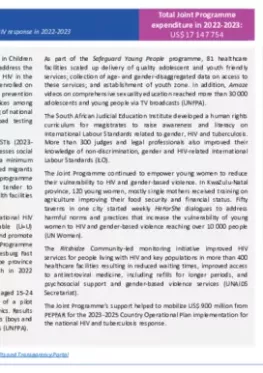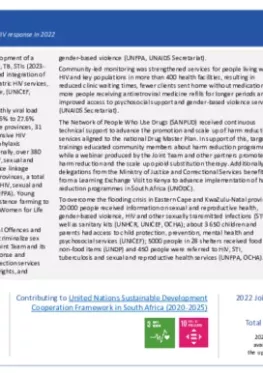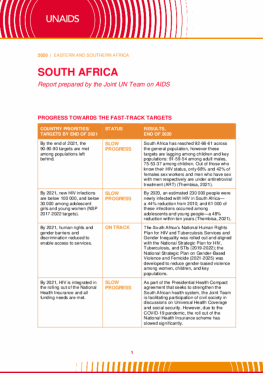|
South Africa
The Joint Programme supported the development of the HIV Prevention Country Roadmap (2025–2028), update of the national voluntary medical male circumcision (VMMC) guidelines and the roll-out of new antiretroviral treatment (ART) guidelines, as well as the expansion of men’s health strategies in three provinces (UNFPA, WHO, UNAIDS Secretariat). External quality assessments for VMMC programme implementation were conducted across nine provinces (WHO). The Joint Programme also contributed to developing South Africa’s new National Drug Master Plan (UNODC).
Addressing the treatment gap among for 32,000 HIV-positive children in the country, the Joint Programme catalysed action and improved accountability through the Global Alliance to End AIDS in Children. A national plan was launched by the Deputy President on World AIDS Day, and 12,000 children have since been initiated on ART (UNICEF, WHO, UNAIDS Secretariat).
Significant efforts were made to increase uptake of HIV services by young people. The HeForShe campaign mobilized about 100 ambassadors, thereby reaching 120,000 individuals and promoting HIV awareness and early detection as well as stronger linkages to care in high-risk social settings (UN WOMEN). Through an innovative pilot programme, an ecosystem involving peer educators, healthcare workers and community stores was established, which ultimately reached about 5,000 adolescents and young people with services in one pilot province alone (UNFPA). School-based initiatives, e.g. Let’s Talk! EUP dialogues and the 16 Days of Activism campaign, reached close to 1,500 young people, promoting awareness and creating safer learning spaces (UNESCO). A peer-led mentoring programme was scaled up to reach over 44,000 pregnant adolescent girls and young women, especially those living with HIV, providing psychosocial support, health education and linkages to care, particularly in high-risk settings (UNICEF).
Economic empowerment programmes trained 350 young women and girls at risk of HIV and gender-based violence, improving their economic resilience and financial independence (UN WOMEN).
Using a peer-led approach, the Know No Borders project, operating in high cross-border mobility areas, equipped over 44,000 individuals with accurate information on HIV and sexual and reproductive health (SRH), empowering them to make informed health decisions (IOM).
The Joint Programme provided technical assistance to conduct a community-led monitoring initiative that surveyed nearly 96,000 patients and 49,000 people living with HIV across over 400 facilities. Improvements were seen in 70% of key indicators monitored, including increased multi-month antiretroviral dispensing and external pickup point usage (UNAIDS Secretariat).
The Joint Programme also contributed to the successful submission of a Global Fund funding request on HIV and TB for US$ 536 million for the period 2025-2028 (UNFPA, UNODC, UN WOMEN, ILO, WHO, UNAIDS Secretariat, IOM). In addition, the National HIV Response Sustainability Framework 2023-2028 was approved, guiding long-term planning and transforming the HIV response beyond 2030 (UNAIDS Secretariat).






